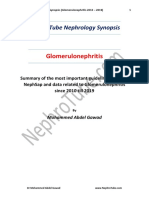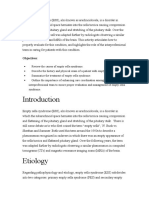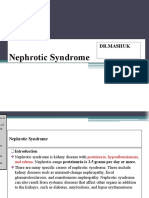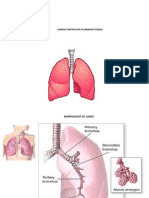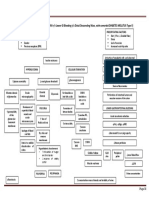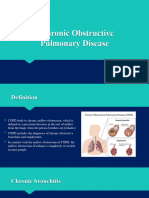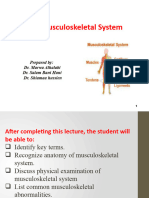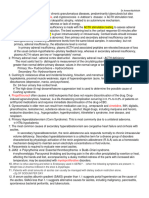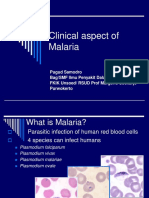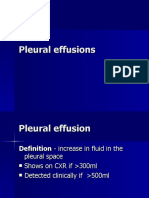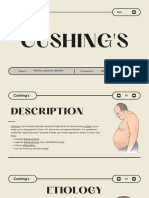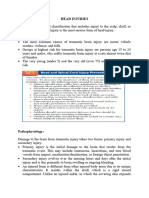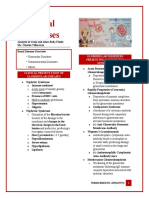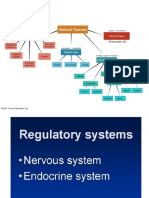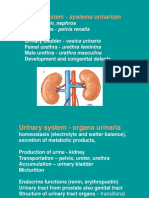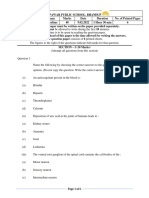Acute Pulmonary Edema - NEJM
Acute Pulmonary Edema - NEJM
Uploaded by
Suzika DewiCopyright:
Available Formats
Acute Pulmonary Edema - NEJM
Acute Pulmonary Edema - NEJM
Uploaded by
Suzika DewiOriginal Title
Copyright
Available Formats
Share this document
Did you find this document useful?
Is this content inappropriate?
Copyright:
Available Formats
Acute Pulmonary Edema - NEJM
Acute Pulmonary Edema - NEJM
Uploaded by
Suzika DewiCopyright:
Available Formats
7/31/13
Acute Pulmonary Edema NEJM
Welcome Guest
Renew, Subscribe or Create Account
Sign In
HOME
ARTICLES & MULTIMEDIA
ISSUES
SPECIALTIES & TOPICS
FOR AUTHORS
CME
Keyw ord, Title, Author, or Citation
Advanced Search
C LINIC A L P RA C T IC E
Acute Pulmonary Edema
Lorraine B. Ware, M.D., and Michael A. Matthay, M.D. N Engl J Med 2005; 353:2788-2796 December 29, 2005 DOI: 10.1056/NEJMcp052699 Share: Article References Citing Articles (112)
TO O LS
PDF Print Download Citation E-Mail Save Article Alert Reprints Permissions Share/Bookmark
This Journal feature begins with a case vignette highlighting a common clinical problem. Evidence supporting various strategies is then presented, followed by a review of formal guidelines, when they exist. The article ends with the authors' clinical recommendations.
TO PICS Pulm onary/ Critical Care Heart Failure Cardiology
MO RE IN Review Decem ber 29, 2005
A 62-year-old man presents with a three-day history of progressive dyspnea, nonproductive cough, and low-grade fever. He had been hospitalized two years earlier for congestive heart failure. His blood pressure is 95/55 mm Hg, his heart rate 110 beats per minute, his temperature 37.9C, and his oxygen saturation while breathing ambient air 86 percent. Chest auscultation reveals rales and rhonchi bilaterally. A chest radiograph shows bilateral pulmonary infiltrates consistent with pulmonary edema and borderline enlargement of the cardiac silhouette. How should this patient be evaluated to establish the cause of the acute pulmonary edema and to determine appropriate therapy?
TRENDS
Most Viewed (Last Week)
O RIGINA L A RT IC LE
THE CLINICAL PROBLEM
The following two fundamentally different types of pulmonary edema occur in humans: cardiogenic pulmonary edema (also termed hydrostatic or hemodynamic edema) and noncardiogenic pulmonary edema (also known as increased-permeability pulmonary edema, acute lung injury, or acute respiratory distress syndrome). Although they have distinct causes, cardiogenic and noncardiogenic pulmonary edema may be difficult to distinguish because of their similar clinical manifestations. Knowledge of the cause of acute pulmonary edema has important implications for treatment. Patients with cardiogenic pulmonary edema typically are treated with diuretics and afterload reduction, although the underlying cause may require other treatment, including coronary revascularization.1 Patients with noncardiogenic pulmonary edema who require mechanical ventilation should be ventilated with a low tidal volume (6 ml per kilogram of predicted body weight) and a plateau airway pressure less than 30 cm of water. This lung-protective strategy of ventilation reduces mortality in patients with acute lung injury.2,3 In addition, for patients with severe sepsis, recombinant activated protein C4 and low-dose hydrocortisone5 should be considered. Prompt diagnosis of the cause of acute pulmonary edema with the use of noninvasive methods, supplemented by catheterization of the pulmonary artery when there is diagnostic uncertainty, facilitates timely and appropriate treatment. Accurate diagnosis of acute pulmonary edema requires an understanding of microvascular fluid exchange in the lung (Figure 1). In the normal lung (Figure 1A), fluid and FIGURE 1 protein leakage is thought to occur primarily through small gaps between capillary endothelial cells. Fluid and solutes that are filtered from the circulation into the alveolar interstitial space normally do not enter the alveoli because the alveolar epithelium is composed of very tight junctions. Rather, once the filtered fluid enters the alveolar interstitial space, it moves proximally into the peribronchovascular space. Under normal conditions the lymphatics remove most of this filtered fluid from the interstitium and return it to the systemic circulation. Movement of larger plasma proteins is restricted. Physiology of Microvascular Fluid The hydrostatic force for fluid filtration across the lung microcirculation is Exchange in the Lung. approximately equal to the hydrostatic pressure in the pulmonary capillaries (Figure 1A), which is partially offset by a protein osmotic pressure gradient. A rapid increase in hydrostatic pressure in the pulmonary capillaries leading to increased transvascular fluid filtration is the hallmark of acute cardiogenic or volume-overload edema (Figure 1B). Increased hydrostatic pressure in the pulmonary capillaries is usually due to elevated pulmonary venous pressure from increased left ventricular end-diastolic pressure and left atrial pressure. Mild elevations of left atrial pressure (18 to 25 mm Hg) cause edema in the perimicrovascular and peribronchovascular interstitial spaces.7 As left atrial pressure rises further (>25 mm Hg), edema fluid breaks through the lung epithelium, flooding the alveoli with protein-poor fluid7 (Figure 1B).
Transmission of Rabies Virus from an Organ Donor to Four Transplant Recipients
March 17, 2005 | A. Srinivasan and Others
C A SE REC O RDS O F T H E M A SSA C H USET T S GENERA L H O SP IT A L
Case 23-2013
July 25, 2013 | K. Kalantar-Zadeh and Others
IM A GES IN C LINIC A L M EDIC INE
A Half-Red Baby
July 25, 2013 | B. Adhisivam and V. Chandrasekaran More Trends
PHYSICIAN JO BS
July 31, 2013
C hiefs/Dir ector s/Dept. H eads
DIRECTOR OF HEPATITIS B PROGRAMS, NEW YORK CITY
NEW YORK
H ospitalist
INTERNAL MEDICINE, HOSPITALIST, TAMPA BAY AREA, FLORIDA
FLORIDA
H ospitalist
HOSPITALIST WANTED IN CENTRAL FLORIDA
FLORIDA
Nephr ology
NEPHROLOGIST BC/BE, JACKSONVILLE, FLORIDA
FLORIDA
H ematology/O ncology
HEMATOLOGIST/ONCOLOGIST
NEW YORK
Inter nal M edicine
Adult Medicine
CONNECTICUT
nejmcareercenter.org
www.nejm.org/doi/full/10.1056/NEJMcp052699
1/4
7/31/13
Acute Pulmonary Edema NEJM
By contrast, noncardiogenic pulmonary edema is caused by an increase in the vascular permeability of the lung, resulting in an increased flux of fluid and protein into the lung interstitium and air spaces (Figure 1C). Noncardiogenic pulmonary edema has a high protein content because the vascular membrane is more permeable to the outward movement of plasma proteins. The net quantity of accumulated pulmonary edema is determined by the balance between the rate at which fluid is filtered into the lung7 and the rate at which fluid is removed from the air spaces and lung interstitium.6
STRATEGIES AND EVIDENCE
Evaluation History and Physical Examination The presenting features of acute cardiogenic and noncardiogenic pulmonary edema are similar. Interstitial edema causes dyspnea and tachypnea. Alveolar flooding leads to arterial hypoxemia and may be associated with cough and expectoration of frothy edema fluid. The history should focus on determining the underlying clinical disorder that has led to pulmonary edema.8 Common causes of cardiogenic pulmonary edema include ischemia with or without myocardial infarction, exacerbation of chronic systolic or diastolic heart failure, and dysfunction of the mitral or aortic valve. Volume overload should also be considered. A typical history of paroxysmal nocturnal dyspnea or orthopnea suggests cardiogenic pulmonary edema. However, a silent myocardial infarction or occult diastolic dysfunction may also manifest as acute pulmonary edema, with few clues provided by the history.9 In contrast, noncardiogenic pulmonary edema is associated primarily with other clinical disorders, including pneumonia, sepsis, aspiration of gastric contents, and major trauma associated with the administration of multiple blood-product transfusions.3 The history should focus on signs and symptoms of infection, a decrease in the level of consciousness associated with vomiting, trauma, and details of medications and ingestions. Unfortunately, the history is not always reliable in distinguishing cardiogenic from noncardiogenic pulmonary edema. For example, an acute myocardial infarction (suggesting cardiogenic edema) may be complicated by syncope or cardiac arrest with aspiration of gastric contents and noncardiogenic edema. Conversely, in patients with severe trauma or infection (suggesting noncardiogenic edema), fluid resuscitation may lead to volume overload and pulmonary edema from an increase in lung vascular hydrostatic pressure. Patients with cardiogenic pulmonary edema often have an abnormal cardiac examination. Auscultation of an S3 gallop is relatively specific for elevated left ventricular end-diastolic pressure and left ventricular dysfunction10-13 and suggests cardiogenic pulmonary edema.10-12 The specificity of this finding is high (90 to 97 percent), but its sensitivity is low (9 to 51 percent).10-13 The wide range of sensitivity probably reflects the difficulty in clearly identifying an S3 gallop on physical examination, a particular challenge in a critically ill patient in whom intrathoracic sounds created by mechanical ventilation interfere with auscultation. Data are lacking on the sensitivity and specificity of other findings on examination for cardiogenic edema. A murmur consistent with valvular stenosis or regurgitation should raise suspicion for the diagnosis of cardiogenic edema. Elevated neck veins, an enlarged and tender liver, and peripheral edema suggest elevated central venous pressure. However, assessment of central venous pressure by physical examination in a critically ill patient can be difficult. Also, peripheral edema is not specific for left heart failure and may be associated with hepatic or renal insufficiency, right heart failure, or systemic infection. The lung examination is not helpful, since alveolar flooding from any cause will manifest as inspiratory crackles and often rhonchi. The abdominal, pelvic, and rectal examinations are important. An intraabdominal crisis such as perforation of a viscus can cause acute lung injury with noncardiogenic edema, and patients who are mechanically ventilated may be unable to provide a history of abdominal symptoms. Patients with noncardiogenic edema often have warm extremities, even in the absence of sepsis, whereas patients with cardiogenic edema and poor cardiac output usually have cool extremities. Laboratory Testing Electrocardiographic findings may suggest myocardial ischemia or infarction. Elevated troponin levels may indicate damage to myocytes. However, elevated troponin levels can occur in patients with severe sepsis in the absence of evidence for an acute coronary syndrome.14-17 In a patient who is obtunded and has pulmonary edema of an unknown cause, measurement of electrolytes, the serum osmolarity, and a toxicology screen may lead to the diagnosis of an unsuspected ingestion. Elevated levels of serum amylase and lipase suggest acute pancreatitis. Plasma levels of brain natriuretic peptide (BNP) are often used in the evaluation of pulmonary edema. BNP is secreted predominantly by the cardiac ventricles in response to wall stretch or increased intracardiac pressures. In patients with congestive heart failure, plasma BNP levels correlate with left ventricular end-diastolic pressure18-21 and pulmonary-artery occlusion pressure.22 According to a consensus panel, a BNP level below 100 pg per milliliter indicates that heart failure is unlikely (negative predictive value, >90 percent), whereas a BNP level greater than 500 pg per milliliter indicates that heart failure is likely (positive predictive value, >90 percent).23 However, BNP levels between 100 and 500 pg per milliliter provide inadequate diagnostic discrimination. BNP levels must be interpreted with caution in critically ill patients, since the predictive value of BNP levels is uncertain in this group. Some reports indicate that BNP levels can be elevated in critically ill patients even in the absence of heart failure.24,25 Levels between 100 and 500 pg per milliliter are common in these patients.26 In one report, all eight patients with sepsis with normal left ventricular function had BNP levels above 500 pg per milliliter.27 Thus, measuring BNP is most useful in critically ill patients if the level is below 100 pg per milliliter. BNP levels are also higher in patients with renal failure independent of heart failure, and a cutoff of below 200 pg per milliliter has
www.nejm.org/doi/full/10.1056/NEJMcp052699
2/4
7/31/13
Acute Pulmonary Edema NEJM
been suggested to exclude heart failure when the estimated glomerular filtration rate is below 60 ml per minute.23 BNP can also be secreted by the right ventricle, and moderate elevations have been reported in patients with acute pulmonary embolism, cor pulmonale, and pulmonary hypertension.23 Chest Radiography The distinct mechanisms of cardiogenic and noncardiogenic pulmonary edema result in some moderately distinguishing findings on a posteroanterior or portable anteroposterior chest radiograph28-30 (Figure 2). In a study of 45 patients with pulmonary edema in FIGURE 2 whom the cause was determined clinically and with the use of sampling of pulmonary edema fluid,31 a composite score based on the radiographic features in Table 1 correctly identified 87 percent of the patients who had cardiogenic edema and 60 percent of those who had noncardiogenic edema. A measurement of the width of the vascular pedicle may improve the diagnostic accuracy of the chest radiograph, but its utility in distinguishing cardiogenic from noncardiogenic edema needs further evaluation.32 There are several explanations for the limited diagnostic accuracy of the chest radiograph. Edema may not be visible until the amount of lung water increases by 30 percent.33 Also, any radiolucent material that fills the air spaces (such as alveolar hemorrhage, pus, and bronchoalveolar carcinoma) will produce a radiographic image similar to that of pulmonary edema. Technical issues can also reduce the sensitivity and specificity of the chest radiograph, including rotation, inspiration, positive-pressure ventilation, position of the patient, and underpenetration or overpenetration of the film. There is also substantial interobserver variability in the interpretation of radiographs.34,35 Echocardiography
Representative Chest Radiographs from Patients w ith Cardiogenic and Noncardiogenic Pulmonary Edema.
TABLE 1
Bedside transthoracic echocardiography can evaluate myocardial and valvular function and can help identify the cause of pulmonary edema.36 Among 49 critically ill patients with unexplained pulmonary edema or hypotension, evaluation of left ventricular function with the use of two-dimensional transthoracic echocardiography and data generated from a pulmonary-artery catheter were in agreement in 86 percent of patients.37 These data, combined with other data from critically ill patients,38 suggest that transthoracic echocardiography should be the first approach to assessing left ventricular and valvular function in patients in whom the history, physical and laboratory examinations, and the chest radiograph do not establish the cause of pulmonary edema. In some critically ill patients the transthoracic echocardiogram may not be sufficiently informative.39 Alternatively, transesophageal echocardiography may be useful,40 with rates of adverse events such as oropharyngeal bleeding, hypotension related to sedation, arrhythmias, and dislodgment of feeding tubes reported to be 1 percent to 5 percent in critically ill patients.41
Radiographic Features That May Help to Differentiate Cardiogenic from Noncardiogenic Pulmonary Edema.
Although echocardiography is effective in identifying left ventricular systolic dysfunction and valvular dysfunction, it is less sensitive in identifying diastolic dysfunction.42 Thus, a normal echocardiogram by standard methods does not rule out cardiogenic pulmonary edema. Newer echocardiographic techniques such as tissue Doppler imaging of the mitral-valve annulus may be used to determine left ventricular end-diastolic pressure and to assess diastolic dysfunction.43 Pulmonary-Artery Catheterization Pulmonary-artery catheterization, used to assess the pulmonary-artery occlusion pressure, is considered the gold standard for determining the cause of acute pulmonary edema.44 Pulmonaryartery catheterization also permits monitoring of cardiac filling pressures, cardiac output, and systemic vascular resistance during treatment. A pulmonary-artery occlusion pressure above 18 mm Hg indicates cardiogenic pulmonary edema or pulmonary edema due to volume overload. In two recent, large, randomized trials of pulmonaryartery catheterization for the management of heart failure or critical illness, the rate of adverse advents was 4.5 to 9.5 percent.45,46 Common complications included hematoma at the insertion site, arterial puncture, bleeding, arrhythmias, and bloodstream infection; there were no fatalities. Measurement of central venous pressure should not be considered a valid substitute for pulmonaryartery catheterization, since available data suggest that there is often a poor correlation between the two.44 Elevated central venous pressure may reflect acute or chronic pulmonary arterial hypertension and right ventricular overload in the absence of any increase in left atrial pressure. Stepwise Approach Our algorithm for the diagnostic approach to the patient with pulmonary edema (Figure 3) has not been validated but instead is based on our clinical experience and on data FIGURE 3 regarding the value of various clinical and laboratory findings for distinguishing the cause of pulmonary edema. Because the noninvasive approaches for diagnosis will inevitably lead to the misclassification of some patients, repeated and ongoing assessment is necessary. Although the presentation of the algorithm is stepwise, providing care to the critically ill patient is a dynamic process, often requiring simultaneous diagnosis and treatment. Thus, some treatments (such as diuretic therapy for suspected Algorithm for the Clinical Differentiation cardiogenic edema, in the absence of a contraindication) may be initiated betw een Cardiogenic empirically before testing (e.g., echocardiography) takes place. In addition, and Noncardiogenic Pulmonary Edema. perhaps 10 percent of patients with acute pulmonary edema have multiple causes of edema.47,48 For example, a patient with septic shock and acute
www.nejm.org/doi/full/10.1056/NEJMcp052699
3/4
7/31/13
Acute Pulmonary Edema NEJM
lung injury may have volume overload due to aggressive fluid resuscitation or myocardial dysfunction, and a patient with acute exacerbation of congestive heart failure may have pneumonia and associated acute lung injury.49 In patients with an uncertain cause or possible multiple causes of edema, insertion of a pulmonary-artery catheter may be necessary.
AREAS OF UNCERTAINTY
We know of no prospective clinical studies that have assessed the relative contribution of the diagnostic methods currently in use for determining the cause of pulmonary edema. In one study that compared pulmonary-artery catheterization with clinical assessment by physicians, catheterization was superior for determining the cause of acute pulmonary edema.50 However, that study predated the routine use of BNP and echocardiography, both of which are likely to increase the sensitivity and specificity of the noninvasive determination of the cause of pulmonary edema.
GUIDELINES
There are currently no published guidelines from professional societies for the differentiation between cardiogenic and noncardiogenic pulmonary edema.
CONCLUSIONS AND RECOMMENDATIONS
For patients presenting with acute pulmonary edema, such as the one described in the vignette, evaluation should begin with a careful history and physical examination. Special attention should be paid to signs and symptoms of acute or chronic cardiac disease, as well as evidence for a primary pulmonary process such as pneumonia or a nonpulmonary source of infection such as peritonitis. An electrocardiogram should be obtained to rule out ischemic changes, although such changes alone would not establish that the pulmonary edema was cardiogenic. Measurement of plasma BNP is warranted and is most useful if the value is below 100 pg per milliliter, a level at which congestive heart failure is unlikely. The chest radiograph should be reviewed with attention to features suggesting cardiogenic edema (e.g., increased heart size and central distribution of edema) as opposed to noncardiogenic edema. If the diagnosis remains uncertain, a transthoracic echocardiogram can evaluate left ventricular systolic function and aortic- and mitral-valve function. With the use of the stepwise approach in the diagnostic algorithm, the majority of patients with acute pulmonary edema will be diagnosed noninvasively, and treatment can be provided while the diagnostic steps are taken. For example, if infection is suspected, antibiotic therapy should be initiated after obtaining appropriate cultures. Similarly, if the patient requires mechanical ventilation, and there is uncertainty about the cause of the pulmonary edema, then a lung-protective strategy of ventilation with a low tidal volume is recommended. In some patients, particularly those in whom shock complicates the pulmonary edema, insertion of a pulmonary-artery catheter is needed to identify the cause of the pulmonary edema and target therapy appropriately.
Supported by grants from the National Heart, Lung, and Blood Institute (NHLBI HL51856 and HL74005, to Dr. Matthay; and NHLBI 70521 and 081332, to Dr. Ware). No potential conflict of interest relevant to this article w as reported.
SOURCE INFORMATION
From the Division of Allergy, Pulmonary and Critical Care Medicine, Department of Medicine, Vanderbilt University School of Medicine, Nashville (L.B.W.); and the Departments of Medicine and Anesthesia and the Cardiovascular Research Institute, University of California, San Francisco, San Francisco (M.A.M.). Address reprint requests to Dr. Ware at the Division of Allergy, Pulmonary and Critical Care Medicine, Vanderbilt University School of Medicine, 1161 21st Ave. S., T1218 MCN, Nashville, TN 37232-2650.
CONTENT: Home Current Issue Articles Issue Index Specialties & Topics Multimedia & Images Archive 1812-1989 INFORMATION FOR: Authors Review ers Subscribers Institutions Media Advertisers SERVICES: Subscribe Renew Pay Bill Activate Subscription Create or Manage Account Alerts RSS & Podcasts Submit a Manuscript Mobile
RESOURCES: Physician Jobs Reprints Permissions Medical Meetings Conventions FAQs NEJM Journal Watch Help Contact Us NEJM: About Product Information Editors & Publishers 200th Anniversary Terms of Use Privacy Policy Copyright Advertising Policies NEJM Group CME: Weekly CME Program Brow se Weekly Exams Your CME Activity Purchase Exams Review CME Program
Follow us
Copyright 2013 Massachusetts Medical Society. All rights reserved.
www.nejm.org/doi/full/10.1056/NEJMcp052699
4/4
You might also like
- Hassan's OSCE-2nd Edition-Trailer Version - 240126 - 204920Document68 pagesHassan's OSCE-2nd Edition-Trailer Version - 240126 - 204920KabirNo ratings yet
- Pathophysiology of Brain TumorsDocument15 pagesPathophysiology of Brain TumorsTRASH MAILNo ratings yet
- Acute Rheumatic FeverDocument39 pagesAcute Rheumatic FeverUzma BanoNo ratings yet
- NephroTube Synopsis - GNDocument41 pagesNephroTube Synopsis - GNSelena GajićNo ratings yet
- Empty Sella SyndromeDocument21 pagesEmpty Sella SyndromeMohamed TarekNo ratings yet
- Potts DiseaseDocument11 pagesPotts DiseasemaricelpngsNo ratings yet
- PathophysiologyDocument5 pagesPathophysiologyzvfvr95hrkNo ratings yet
- Liver Function Tests - عالم المختبرات و التحاليل الطبيةDocument7 pagesLiver Function Tests - عالم المختبرات و التحاليل الطبيةhamadadodo7No ratings yet
- Acute PancreatitisDocument5 pagesAcute PancreatitisSophia RubiaNo ratings yet
- Empty Sella SyndromeDocument2 pagesEmpty Sella Syndromewawan_291289100% (1)
- 2 Diabetes Mellitus and DiagnosticDocument33 pages2 Diabetes Mellitus and DiagnosticSifa RismawatiNo ratings yet
- Endocrine Pathology LectureDocument31 pagesEndocrine Pathology Lectureninja2007No ratings yet
- Poisoning SeminarDocument33 pagesPoisoning SeminarRamprasad JagtapNo ratings yet
- Addison 'S Disea Se: Layne A BreuDocument8 pagesAddison 'S Disea Se: Layne A Breudavelnx2291No ratings yet
- Disorders of AdrenalsDocument8 pagesDisorders of AdrenalsM.PRASAD NAIDUNo ratings yet
- Parkinson Disease FinalDocument11 pagesParkinson Disease Finalicrs_aamirNo ratings yet
- +nephrotic SyndromeDocument22 pages+nephrotic SyndromeDr. SAMNo ratings yet
- Chronic Obstructive Pulmonary DiseaseDocument33 pagesChronic Obstructive Pulmonary DiseasealexpharmNo ratings yet
- Cardiac Tamponade GuidelineDocument11 pagesCardiac Tamponade GuidelinePrasant GanesenNo ratings yet
- Management Of: Septic ShockDocument29 pagesManagement Of: Septic ShockVijay ChallaNo ratings yet
- Nephrotic Syndrome DhalayanDocument18 pagesNephrotic Syndrome DhalayanArifaNo ratings yet
- The Parathyroid Gland: DR - Umalkhayr Omar, MDDocument36 pagesThe Parathyroid Gland: DR - Umalkhayr Omar, MDgibreilNo ratings yet
- Anemia PathoDocument1 pageAnemia PathoKathleen EvizaNo ratings yet
- Parkinson Disease - AMBOSSDocument1 pageParkinson Disease - AMBOSSakillaNo ratings yet
- 01 Primary Health CareDocument60 pages01 Primary Health CareLesly Marie LaxamanaNo ratings yet
- Paragraph On Campus LifeDocument1 pageParagraph On Campus LifeTasebe GetachewNo ratings yet
- COPDDocument15 pagesCOPDlouirufi3003No ratings yet
- Headache NewDocument17 pagesHeadache NewHaris PeaceNo ratings yet
- Cerebro Vascular AccidentDocument55 pagesCerebro Vascular AccidentShalem. KNo ratings yet
- Hypoglycemia in NewbornDocument10 pagesHypoglycemia in Newbornmaxim tomuNo ratings yet
- Musculoskeletal Assessment2023Document63 pagesMusculoskeletal Assessment2023ehabeideh11No ratings yet
- Paediatric Septic ShockDocument37 pagesPaediatric Septic ShockJavedgouri GouriNo ratings yet
- Internal medicine שחזוריםDocument66 pagesInternal medicine שחזוריםLaith Bajis Nassar100% (1)
- Introduction To The Nervous System and Nerve TissueDocument42 pagesIntroduction To The Nervous System and Nerve TissueNicole Anne TungolNo ratings yet
- Glomerular Diseases-Part 1Document68 pagesGlomerular Diseases-Part 1hrg79qzwc2100% (1)
- Clinical Aspect of MalariaDocument68 pagesClinical Aspect of MalariaselviaNo ratings yet
- Pleural EffusionsDocument79 pagesPleural EffusionsDiana_anca6No ratings yet
- Introduction To Nervous SystemDocument12 pagesIntroduction To Nervous Systemniman abdirahmanNo ratings yet
- Acute Respiratory FailureDocument40 pagesAcute Respiratory FailureVincent Remy CanalesNo ratings yet
- Cushing SyndromeDocument15 pagesCushing Syndromeandrea.maungca.mnl100% (1)
- Head InjuryDocument11 pagesHead InjurypertinenteNo ratings yet
- Traumatic Brain InjuryDocument40 pagesTraumatic Brain InjuryRed DevilNo ratings yet
- Approach To ProteinuriaDocument14 pagesApproach To ProteinuriaRishi ShresthaNo ratings yet
- Glossopharngeal NerveDocument20 pagesGlossopharngeal NerveDevasyaNo ratings yet
- Renal DiseaseDocument4 pagesRenal DiseaseApril Lady Faith P. PaundogNo ratings yet
- Hyper and Hypoaldosteronism - G1Document39 pagesHyper and Hypoaldosteronism - G1Jazh AyochokNo ratings yet
- Respiratory System: Haitham N.KhalidDocument71 pagesRespiratory System: Haitham N.KhalidJockerNo ratings yet
- Acute Pulmonary Edema - Nitrate or Diuretic Dr. Heny Martini, SPJP (K) PDFDocument50 pagesAcute Pulmonary Edema - Nitrate or Diuretic Dr. Heny Martini, SPJP (K) PDFmgoez077No ratings yet
- Approach To Unconscious PatientDocument40 pagesApproach To Unconscious Patientjun sianNo ratings yet
- Acute Liver FailureDocument43 pagesAcute Liver FailureÁýáFáŕőúgNo ratings yet
- Hypertensive Crisis: Syed RazaDocument45 pagesHypertensive Crisis: Syed RazaAndika HNo ratings yet
- Glomerulonephritis PresentationDocument23 pagesGlomerulonephritis Presentationjacksonyu1234No ratings yet
- Clinical Approach To Anemia: Fakultas Kedokteran Universitas Prima IndonesiaDocument24 pagesClinical Approach To Anemia: Fakultas Kedokteran Universitas Prima IndonesiaDzil FikriNo ratings yet
- SeizuresDocument5 pagesSeizuresLeah SalcedoNo ratings yet
- Hemorraghic StrokeDocument4 pagesHemorraghic StrokeRachelle Delantar100% (1)
- Acute Pulmonary Edema in PregnancyDocument20 pagesAcute Pulmonary Edema in PregnancyUtomo Budidarmo100% (1)
- Cyanosis FinalDocument41 pagesCyanosis FinalSyed MoideenNo ratings yet
- Guidelines For Third-Year Students of The Medical DepartmentDocument9 pagesGuidelines For Third-Year Students of The Medical Departmenthealer sruthy100% (1)
- Lecture - 3 Properties of Cardiac MuscleDocument35 pagesLecture - 3 Properties of Cardiac MuscleMRM7MDNo ratings yet
- Pulmonary Arterial Hypertension in Congenital Heart Disease: Eisenmenger’s Syndrome - A Global PerspectiveFrom EverandPulmonary Arterial Hypertension in Congenital Heart Disease: Eisenmenger’s Syndrome - A Global PerspectiveNo ratings yet
- 7 - Anatomy of The Pancreas and Spleen00Document18 pages7 - Anatomy of The Pancreas and Spleen00Maya Lyara EdittingNo ratings yet
- Anatomy For Pharmacists 2018Document10 pagesAnatomy For Pharmacists 2018hzol83No ratings yet
- Endocrinology SlidesDocument344 pagesEndocrinology SlidesleanNo ratings yet
- Ciclul CardiacDocument1 pageCiclul CardiacAurelia AlexandraNo ratings yet
- BIO621 Chapter 2Document135 pagesBIO621 Chapter 2MizahNo ratings yet
- Patologia Inflamatorie A Sânului: DR Panuța AndrianDocument31 pagesPatologia Inflamatorie A Sânului: DR Panuța AndrianPanuta AndrianNo ratings yet
- Bagga NephrologyDocument291 pagesBagga NephrologyAnangsha DattaNo ratings yet
- Pancreatic Cancer StagingDocument1 pagePancreatic Cancer StagingShashankNo ratings yet
- Airway-Anatomy: Maj Yuvraj Issar Resident Oral & Maxillofacial SurgeryDocument83 pagesAirway-Anatomy: Maj Yuvraj Issar Resident Oral & Maxillofacial SurgeryBhanu PraseedhaNo ratings yet
- Anatomy and Physiology PretestDocument2 pagesAnatomy and Physiology PretestMary Regine BalacuitNo ratings yet
- I. Human Body OrientationDocument10 pagesI. Human Body OrientationAnn Margarette MoralesNo ratings yet
- SIADH, DI and Cerebral Salt Wasting: Karim Rafaat, MDDocument54 pagesSIADH, DI and Cerebral Salt Wasting: Karim Rafaat, MDMahendra PrasetyoNo ratings yet
- Renal Disease: Acute Kidney Injury (AKI)Document5 pagesRenal Disease: Acute Kidney Injury (AKI)api-142637023No ratings yet
- Jawab Semua Soalan Dalam Kertas Ini.: Instructions / Arahan: Answer All Questions in This Paper MarksDocument12 pagesJawab Semua Soalan Dalam Kertas Ini.: Instructions / Arahan: Answer All Questions in This Paper MarksBye Zuera OthmanNo ratings yet
- The Digestive System Challenges and OpportunitiesDocument9 pagesThe Digestive System Challenges and OpportunitiesPhelipe PessanhaNo ratings yet
- Thyroid Disease: Dr. Gusti Hariyadi Maulana, MSC, SPPD-KGH Internist-NephrologistDocument30 pagesThyroid Disease: Dr. Gusti Hariyadi Maulana, MSC, SPPD-KGH Internist-NephrologistNurul HikmaNo ratings yet
- Nervous System-2022-23 Asi̇stDocument101 pagesNervous System-2022-23 Asi̇stYiğit GündüzNo ratings yet
- Referat Hipertensi - GeriatriDocument21 pagesReferat Hipertensi - GeriatriAndrew SoerijadiNo ratings yet
- Acupressure Points To Stay FitDocument6 pagesAcupressure Points To Stay FitWafaa Abdel AzizNo ratings yet
- ParasympatisDocument28 pagesParasympatisMeity ElvinaNo ratings yet
- The Miracle of LifeDocument6 pagesThe Miracle of LifeKiseKunNo ratings yet
- Digestive System ScriptDocument7 pagesDigestive System ScriptGeraldine Co TolentinoNo ratings yet
- Kidney ThesisDocument8 pagesKidney Thesisbsfp46eh100% (3)
- Sistemul UrinarDocument46 pagesSistemul UrinarMoga MihaelaNo ratings yet
- 7 Science NCERT Solutions Chapter 2Document6 pages7 Science NCERT Solutions Chapter 2preethaNo ratings yet
- Pathophysiology: Menstrual CycleDocument44 pagesPathophysiology: Menstrual CycledirinaNo ratings yet
- Bio PawarDocument6 pagesBio PawarShayan BiswasNo ratings yet
- Giant Juvenile Fibroadenoma of Breast Mimicking Phylloides Tumour - A Case ReportDocument8 pagesGiant Juvenile Fibroadenoma of Breast Mimicking Phylloides Tumour - A Case ReportsridharNo ratings yet
- Lecture Notes in Anatomy Gross Anatomy of The Oral CavityDocument6 pagesLecture Notes in Anatomy Gross Anatomy of The Oral Cavitykasonde bowaNo ratings yet



